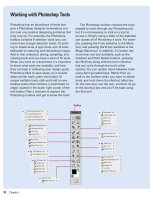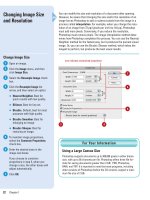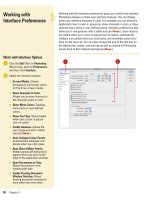Photoshop cs5 by steve Johnson part 47 ppsx
Bạn đang xem bản rút gọn của tài liệu. Xem và tải ngay bản đầy đủ của tài liệu tại đây (611.16 KB, 6 trang )
ptg
292 Chapter 12
The Bevel and Emboss layer styles have two powerful options: the
ability to add a contour or a texture to the active bevel or emboss. This
lets you give your creative elements more of a realistic texture. When
you apply the Contour and Texture options, the image takes on a three
dimensional texture, based on a selected pattern. Once applied, the rel-
ative depth and intensity of the texture can be precisely controlled to
create rough rock-like surfaces, as well as brushed metal. In addition,
the Contour option lets you shape the appearance of the shadow areas
of the texture style, creating even more realistic surfaces.
Working with Contour
and Texture
Work with Contour and Texture
Select the Layers panel.
Select the layer to which you want
to apply the Bevel and Emboss
style.
Click the Add Layer Style button,
and then click Bevel and Emboss.
Select the appropriate bevel or
emboss.
Click Contour, and then select
from the available options:
◆ Contour. Click the list arrow,
and then select from the
available options. Contours are
mathematical curves that
determine the brightness of the
bevel or emboss at different
levels (default: Linear).
◆ Anti-aliased. Select the check
box to create a visually smooth
bevel or emboss.
◆ Range. Enter a value from 1%
to 100%, or drag the slider left
or right. Range determines
the range of the contour as
it is applied to the image
(default: 50%).
5
4
3
2
1
5
Contour options
See Also
See “Working with Bevel and Emboss”
on page 290 for more information on
using the Contour option.
From the Library of Wow! eBook
ptg
Chapter 12 Working with Layer Styles 293
Click Texture, and then select from
the available options:
◆ Pattern. Click the list arrow, and
then select from the available
patterns. To add additional
patterns from the Photoshop
pattern library, click the Pattern
Options button, located in the
upper right of the Pattern dialog
box, and then select from the
available pattern options.
◆ Add To Presets. Click the button
to add the current pattern to
Photoshop’s list of presets.
◆ Snap To Origin. Click the button
to begin the pattern tiling from
the upper left corner of the
document layer.
◆ Scale. Enter a value from 1% to
1,000%. Scale determines the
size of the pattern as it applies
to the active image (default:
100%).
◆ Depth. Enter a value from
-1000% to 1000%. Depth
determines the intensity of the
highlight and shadow areas in
the texture. Negative numbers
reverse the highlights and
shadows (default: 100%).
◆ Invert. Select the check box to
reverse the color set of the
pattern.
◆ Link With Layer. Select the
check box to physically link the
active pattern with the active
layer (default: checked).
Click OK.
7
6
Contour and Texture style applied
6
7
Text ure op ti ons
From the Library of Wow! eBook
ptg
294 Chapter 12
The Color Overlay style covers the elements of a layer with any color
you choose. For example, you create some black text and you want to
experiment with other colors, without changing the original color val-
ues of the text. Or, possibly you want to change the Blend Mode option,
so you can see how a specific color blends into the image. Whatever
the case, Color Overlay temporarily masks the image with whatever
color you choose. In addition, you can use the Color Overlay style with
other layer styles to produce hundreds, if not thousands, of style
combinations.
Applying a Color
Overlay
Apply a Color Overlay
Select the Layers panel.
Click the layer to which you want
to apply the Color Overlay style.
Click the Add Layer Style button,
and then click Color Overlay.
Select from the available Color
Overlay options:
◆ Blend Mode. Click the list
arrow, and then select from the
available options. The Blend
Mode option instructs
Photoshop how to blend the
selected Color Overlay with the
colors of the active image
(default: Normal).
◆ Color. Click the Color swatch
box, and then select any color
from the Color Picker (default:
red).
◆ Opacity. Enter a value from 0%
to 100%. Opacity determines
how much of the Color Overlay
masks the original image pixels
(default: 100%).
Click Make Default to remember
current settings for this effect or
click Reset to Default to change
settings to the default (New!).
Click OK.
6
5
4
3
2
1
4
6
Color Overlay style applied
5
From the Library of Wow! eBook
ptg
Chapter 12 Working with Layer Styles 295
The Stroke Layer style lets you apply a stroke around any layer object.
Since the stroke will be applied to the edge of the object, it must be
surrounded by transparent pixels. For example, you could use the
stroke feature to apply a solid color around text outlines, or apply a
stroke around an image. Strokes are not limited to solid colors; you can
also use gradients and even patterns as a stroke. The Stroke Layer
style can provide you with many interesting styles.
Using the Stroke
Layer Style
Use the Stroke Layer Style
Select the Layers panel.
Select the layer to which you want
to apply the Stroke Layer style.
Click the Add Layer Style button,
and then click Stroke.
Select from the Stroke options:
◆ Size. Enter 1 to 250 pixels to
define the width of the stroke.
◆ Position. Click the list arrow,
and then select to place the
stroke on the Outside, Inside, or
Center of the layer object.
◆ Blend Mode. Click the list
arrow, and then select from the
available options. The Blend
Mode option instructs
Photoshop how to blend the
selected Stroke color with the
colors of the active image.
◆ Opacity. Enter a value from 0%
to 100%, or drag the slider left
or right. Opacity determines
how much of the Stroke masks
the original image pixels.
◆ Fill Type. Click the list arrow,
and then select to create a
stroke from a solid color,
gradient, or pattern.
◆ Color. Click the color box, and
then select a color.
Click Make Default to remember
current settings for this effect or
click Reset to Default to change
settings to the default (New!).
Click OK.
6
5
4
3
2
1
6
Stroke Layer style applied
5
4
From the Library of Wow! eBook
ptg
296 Chapter 12
Pattern Overlays replace the pixels in the active layer with a specific
pattern. Photoshop comes equipped with dozens of preexisting pat-
terns, or you can create and save your own. Patterns can be used to
spice up an otherwise dull area of an image—like covering a com-
pletely white wall in your house with decorative wallpaper. When you
apply a pattern, the original image is overlaid with the selected pattern,
and once that's accomplished you can use blending modes and opacity
to control the effect the pattern has on the original image.
Using Pattern
Overlays
Use Pattern Overlay
Select the Layers panel.
IMPORTANT
Pattern Overlays,
like all of Photoshop's layer styles,
are applied to all the non-
transparent pixels in the image.
You cannot use a selection to
control what areas of the image
are affected by the layer style.
Click the layer to which you want
to apply the Pattern Overlay style.
Click the Add Layer Style button,
and then click Pattern Overlay.
Select from the available Pattern
Overlay options:
◆ Blend Mode. Click the list
arrow, and then select from the
available options. The Blend
Mode option instructs
Photoshop how to blend the
selected Pattern Overlay with
the colors of the active image
(default: Normal).
◆ Opacity. Enter a value from 0%
to 100%. Opacity determines
how much of the Pattern
Overlay masks the original
image pixels (default: 100%).
For example, 50% opacity
would let 50% of the original
colors blend with the Pattern
Overlay.
4
3
2
1
4
Using Pattern Overlays
You can use a pattern overlay on a photograph. Normally, a pattern
completely covers the original image information; however, if you
use different Blending Mode options when you apply the pattern,
you can achieve some interesting results. Experiment with photo-
graphs and patterns using the Multiply, Screen, and Overlay blend-
ing modes to start. The style is a combination of the pattern blending
with the photograph.
For Your Information
From the Library of Wow! eBook
ptg
Chapter 12 Working with Layer Styles 297
◆ Pattern. Click the list arrow,
and then select from the
available patterns. To add
additional patterns from the
Photoshop pattern library, click
the Pattern Options button,
located in the upper right of the
pattern dialog box, and then
choose from the available
pattern options.
◆ Add To Presets. Click the
button to add the current
pattern to Photoshop’s list of
presets.
◆ Snap To Origin. Click the
button to begin the pattern
tiling from the upper left corner
of the document layer.
◆ Scale. Enter a value from 1% to
1,000%. Scale determines the
size of the pattern as it applies
to the active image (default:
100%).
◆ Link With Layer. Select the
check box to physically link the
active pattern with the active
layer (default: checked).
Click Make Default to remember
current settings for this effect or
click Reset to Default to change
settings to the default (New!).
Click OK.
6
5
6
Pattern Overlay style applied
Did You Know?
You can reposition any Pattern
Overlay.
Open the Layer Style dialog
box and click any pattern from the
Pattern library. However, before you
click OK, move into the document win-
dow and drag. The pattern is reposi-
tioned as you drag. Click the Snap To
Origin button to return the pattern to its
default position.
5
From the Library of Wow! eBook









